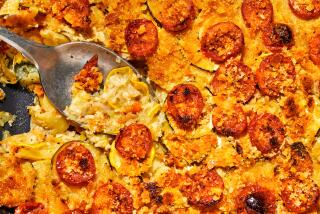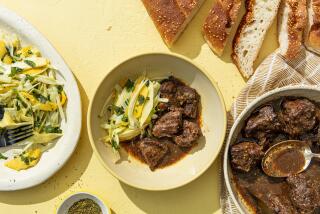The Spanish Way With Simplicity
There are recipes you dabble with, trying them once before moving on to others. Then there are the ones that stick with you, that become part of your everyday repertoire. They don’t need to be especially fancy--in fact, usually they’re not. More often, they’re simple things that teach you a new technique or show you another face of a familiar ingredient.
The most recent example of this for me was Gazpacho Hoy from Janet Mendel’s new book, “My Kitchen in Spain” (HarperCollins, $34.95). Gazpacho is one of those dishes I’ve never really “gotten”--is it a soup? Is it a salsa? And what’s with all that chopping? But Mendel’s version is so simple to prepare, yet so satisfying, that I know it is one I will be making over and over.
Here’s how it goes: Puree garlic and bread you’ve soaked in water. Add chopped tomatoes and a little cumin and puree again, adding olive oil, a little vinegar and water. Now take your afternoon nap while it chills in the refrigerator. When you wake up, you’ll have one of the best cold soups you’ve ever tasted.
What’s that, you say? No cucumbers, no bell peppers, no meticulously minced everything? You can do all that stuff if you want, and serve it as a garnish, but it’s not necessary. The depth and complexity of flavor of the basic recipe is astonishing--provided you use good tomatoes.
This recipe is typical of the rest of the book, at least in approach. Take basic ingredients and cook them simply but with imagination. Mendel builds complexity not through the layering of many flavors but through the careful use of a very few. There’s only one-fourth teaspoon of cumin in the gazpacho, and you certainly won’t taste it for itself. But it is just enough to add a certain earthy bottom note to the sweetness of the tomatoes.
The use of bread as a thickener is repeated in other recipes as well. With the gazpacho, it adds a creamy texture as well as softening the bite of the raw garlic a bit. It does much the same thing in the green beans with garlic sauce, another extremely simple dish that will probably wind up on my table again. In this one, blanched green beans are sauteed in olive oil with red pepper strips, then the whole thing is lightly bound by further cooking with bread softened in vinegar and pureed with garlic and some of the liquid from the green beans. Just a dash of pimenton is the “complexer” this time.
Other recipes I tested were successful, though less world-shaking. I was pleased that the Basque red bean stew called for cooking the beans without pre-soaking--something I’ve long advocated. And I was interested in the technique of “scaring” the beans periodically, slowing down the cooking with occasional additions of cold water. The texture of the beans was perfect, and the flavor was good (well, with chorizo, ham hock and beans, how could it not be?). But I did find that the dish needed a little vinegar at the end to really lift the flavor.
As you probably can tell from the descriptions, these are not fancy dishes and neither do they go overboard in the quest for authenticity.
Most of the ingredients called for can be found in any supermarket. Rather, this is exactly what the title implies: real-world food from a very talented cook.
And you’ll probably find, as I did, that not a few of the dishes from her Spanish kitchen wind up as regular visitors to yours.
*
Zucchini and Potato Gratin, Balearic Style
(Tumbet Balear)
Active Work Time: 45 minutes * Total Preparation Time: 1 hour, 15 minutes * Vegetarian
1/4 cup plus 1 tablespoon olive oil, plus more for preparing pan
1 tablespoon fine dry bread crumbs
1 1/2 cups diced tomatoes
1/2 teaspoon crumbled dried basil
1/2 teaspoon sugar
3 teaspoons salt, divided
1 1/2 pounds boiling potatoes, thinly sliced
1 1/2 pounds zucchini, cut in 1/4-inch slices
1 onion, sliced
4 eggs, beaten with 1 tablespoon water
1 red bell pepper, roasted, peeled and cut into strips
Heat the oven to 350 degrees. Oil a 13-by-9-inch baking pan or casserole and dust with the bread crumbs.
Heat 1 tablespoon of the oil in a saucepan over medium heat and add the tomatoes, basil, sugar and 1 teaspoon of the salt. Cook the tomatoes until the liquid is reduced, 10 minutes. Set aside.
In a large skillet, heat the remaining 1/4 cup of oil and fry the potato slices slowly, turning to cook evenly, until they are fork-tender, about 15 minutes. They do not need to brown. Sprinkle the potatoes with 1 teaspoon of the salt while they are cooking. Remove the potatoes from the skillet and spread in the bottom of the baking pan.
Add the zucchini and onion to the oil remaining in the skillet and cook over medium heat until the zucchini is fork-tender, about 10 minutes. Sprinkle with the remaining 1 teaspoon of salt.
Pour a quarter of the beaten eggs over the potatoes. Spread the zucchini and onion over the potatoes. Add another quarter of the eggs. Lay strips of roasted pepper over the zucchini and pour a quarter of the eggs over. Top with the tomato sauce. Pour the remaining egg over the casserole.
Bake 25 minutes. Let set for 5 minutes before serving.
6 to 8 servings. Each of 8 servings: 178 calories; 637 mg sodium; 103 mg cholesterol; 8 grams fat; 2 grams saturated fat; 23 grams carbohydrates; 6 grams protein; 3.03 grams fiber.
*
Today’s Gazpacho (Gazpacho Hoy)
Active Work Time: 20 minutes * Total Preparation Time: 1 1/2 hours, plus 1 hour chilling
4 ounces (about 4 slices) stale bread, crusts removed
2 cloves garlic
2 pounds tomatoes, seeded and coarsely chopped
1 (2-inch-square) piece green bell pepper, optional
1 (2-inch) chunk peeled cucumber, optional
1/4 teaspoon ground cumin
2 teaspoons salt
1/3 cup olive oil, preferably extra-virgin
2 tablespoons white wine vinegar
1 1/2 cups water
1/3 cup chopped green bell pepper, for optional garnish
1/3 cup chopped white onion, for optional garnish
1/3 cup peeled, chopped cucumber, for optional garnish
1/2 cup croutons or diced bread, toasted crisp, for optional garnish
Break the bread into big chunks and soak it in water to cover until it is softened, about 15 minutes. Squeeze out the excess water and place the bread in a blender or food processor with the garlic. Blend until the bread and garlic are smooth, scraping down the sides as necessary.
Add the tomatoes (it may be necessary to process the tomatoes in 2 batches) and the pieces of pepper and cucumber, if using, and puree. Add the cumin and salt. With the blender on, add the olive oil in a slow stream. As the oil is incorporated, the gazpacho will turn from tomato-juice red to a paler, orange color. Blend in the vinegar and enough water to make the desired thickness.
Place the gazpacho into a tureen, bowl or pitcher and chill until serving time.
Place each of the garnishes--chopped peppers, onion, cucumber and croutons--in small bowls or on a relish dish and pass them when the gazpacho is served. This gazpacho also can be served, thinned with additional water, in tall glasses for sipping, without the garnishes.
4 to 6 servings. Each of 6 servings: 191 calories; 915 mg sodium; 0 cholesterol; 13 grams fat; 2 grams saturated fat; 17 grams carbohydrates; 3 grams protein; 2.25 grams fiber.
More to Read
Eat your way across L.A.
Get our weekly Tasting Notes newsletter for reviews, news and more.
You may occasionally receive promotional content from the Los Angeles Times.










